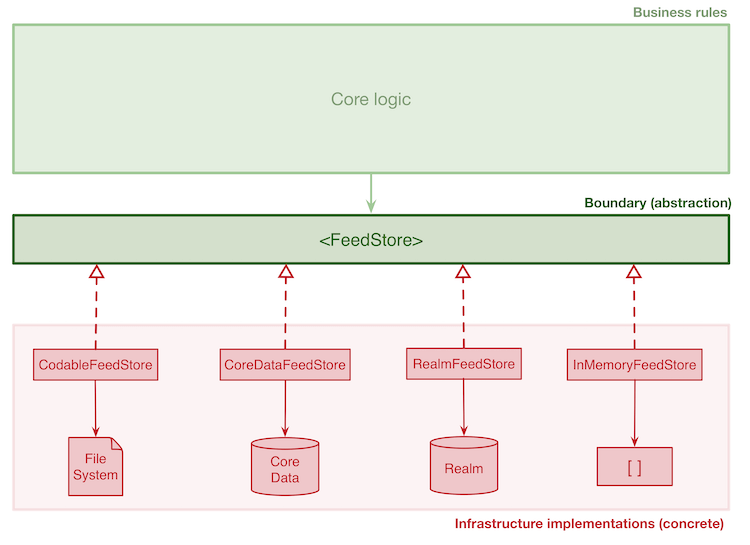You are called to build your own persistence infrastructure implementation by creating a new component that conforms to the <FeedStore> protocol.
Your custom persistence infrastructure implementation can be backed by any persistence stack you wish, i.e. CoreData, Realm, in memory, etc, as shown in the diagram below.
-
Fork the latest version of this repository. Here's how forking works.
-
Open the
FeedStoreChallenge.xcodeprojproject on Xcode 12.2 (you can use other Xcode versions by switching to the appropriate branch, e.g.,xcode11/xcode12). -
Implement one
<FeedStore>implementation of your choice (CoreData, Realm, InMemory, etc.). -
Use the
Tests/FeedStoreChallengeTests.swiftto validate your implementation. Uncomment and implement one test at a time following the TDD process: Make the test pass, commit, and move to the next one. -
If your implementation has failable operations (e.g., it might fail to load data from disk), uncomment and implement the failable test extensions at the bottom of the
Tests/FeedStoreChallengeTests.swifttest file. -
If your implementation persists data to disk (e.g., CoreData/Realm), you must use the
Tests/FeedStoreIntegrationTests.swiftto check this behavior. Uncomment and implement one test at a time following the TDD process: Make the test pass, commit, and move to the next one. -
When all tests are passing and you're done implementing your solution, create a Pull Request from your branch to the main challenge repo. Use the name of your implementation as the title for the Pull Request, for example, "CoreData implementation - Your name".
8) Post a comment in the challenge page in the academy with the link to your PR, so we can review your solution and provide feedback.
-
Aim to commit your changes every time you add/alter the behavior of your system or refactor your code.
-
Aim for descriptive commit messages that clarify the intent of your contribution which will help other developers understand your train of thought and purpose of changes.
-
The system should always be in a green state, meaning that in each commit all tests should be passing.
-
The project should build without warnings.
-
The code should be carefully organized and easy to read (e.g. indentation must be consistent).
-
Make careful and proper use of access control, marking as
privateany implementation details that aren’t referenced from other external components. -
Aim to write self-documenting code by providing context and detail when naming your components, avoiding explanations in comments.
-
Aim to declare dependencies explicitly, leveraging dependency injection wherever necessary.
-
Aim not to block the main thread - run expensive operations in a background queue.
Happy coding!
